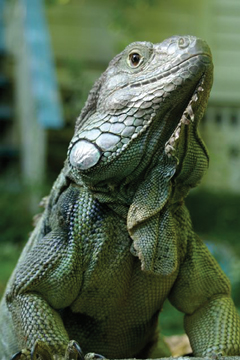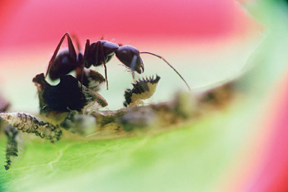June/July
2007
Altered
Reality
The Satya Interview with Jayne Hinds Bidaut
|
 |
Lizzie the iguana.
©Jayne
Hinds Bidaut/2007/ usa212.802.7670
|
Jayne Hinds Bidaut is a fine art photographer native
to Texas who lived and worked in France for several years. In the early
1990s she moved
to New York City where she is currently based. Jayne is well known for
rediscovering and mastering the early photographic process of the tintype.
To date she has
published two books, Tintypes and Animalerie (featured in Satya, May 2005). Her
work is widely exhibited and collected internationally by museums and corporate
and private collections.
Jayne is also the director of The Kageno Kids Art and Cultural Exchange, an outreach
program of Kageno Worldwide, an international not-for-profit community development
organization currently operating in Kenya and Rwanda. Kageno Kids is their multifaceted
creative educational program focusing on the children in these poverty stricken
areas and in local communities in the U.S.
Jayne resides with and cares for Lizzie, an 11 year-old male iguana she rescued
from a boy who was “upgrading” to a python and keeping Lizzie in
a Tupperware container. Lizzie and Jayne met nine years ago at a herpetological
show while shooting her Animalerie series. Although Jayne had never thought about
taking in an iguana, today she can’t imagine her life without him.
Satya consulting editor Rachel Cernansky visited Jayne
Hinds Bidaut’s NYC
studio in April to chat with her about some of the things that inspire and motivate
her work, about perception and animals, and what Lizzie has been able to teach
her.
You seem to appreciate what is not automatically visible to the eye.
Yes, I do seem to always focus on the unseen or forgotten. This is instinctual
and I see now I have done this from an early age…automatically looking
behind the veil of our perception. Even when my work appears familiar and looks
simple, it is actually symbolic and ingrained with personal meaning. I sometimes
use skeletons and things that typically represent death, but they represent the
subconscious for me. I believe your subconscious is guiding you and is an integral
part of your waking day. You don’t acknowledge it, don’t realize
it—you take it for granted. It is supporting you, guiding how you maneuver
through your environment and is giving shape to your entire being.
Insects are very meaningful, in this aspect, for me as well. They are a metaphor
for the psychological growth that we go through, the stages that are unseen and
we must pass through in order to grow—our metamorphosis. We are actually
born nymphs when you think about it! Then as we grow, we shed our mind’s
skin, leaving behind our old selves at each stage.
Do any of the other animals in your art carry a similar symbolism for you?
Yes, but they are also very respectful and about their personal unseen story
and voice. Before Animalerie, I was working on “Après le Marche” [after
the market] in Paris. On market days, people come from their farms to sell an
unbelievable assortment of very fresh produce [and animal products], and when
they leave it feels something like the brief time just after a ticker tape parade,
when everyone is gone and you are alone walking knee-deep in shredded paper.
This same transient time, right after the market venders left, was a very intense
and eerie time and place for me. Discarded and forgotten bits were strewn about
the ground, things that we deem unimportant, just trash—but they were body
parts…chicken heads, chicken feet, baby chicks with their heads torn off,
prawn tails, fish tails, fish heads, fish gills, and random eyeballs. It’s
all these parts that the organism valued and needed in order to live. And people,
in an instant, just cut these off to leave behind, not even thinking about it.
I’d photograph these things while the street sweepers would come with their
plastic brooms and water and brush it all away. I would go from market to market
photographing, voyeuristically, these things of no value that were now only precious
to me. I wouldn’t touch or move or manipulate anything while photographing.
These were my little Flemish still-lifes that were fit to hang in the finest
museums.
 |
This ant and leaf hopper
colony live a symbiotic existence. ©Jayne Hinds Bidaut/2007/
usa212.802.7670 |
How did Animalerie get started?
I started this body of work in France—the title is Animalerie, which is
French and simply translates into “animal shop.” The images in Animaleriewere
taken in pet shops all over the U.S. and in Europe over a period of three years.
From the beginning I did not call it “Pet Shop” because people
would come to the work thinking that they already knew what it was about…therefore
going away gaining nothing from it. The photos are purposefully made to first
beguile and draw the viewer in with photographically interesting and beautiful
pictures. After they are deemed valid and worthy to squander time looking at,
the viewer is already there and connected, and can then realize what they are
seeing.
With Animalerie, I wanted to reach an audience that might not normally
think about these issues. My way of reaching people tends to be through the
back door,
entering directly into the subconscious, letting it take hold, then one day
hopefully it surfaces…and if it never does, then at least you have communicated
to their subconscious. This is what I believe art does: really strong, purposeful,
timeless, meaningful art, communicated from soul to soul.
The initial conceptual and continual driving force behind Animalerie was to show
these animals as commodities. I began photographing the animals in their containers/cages
showing hints and bits of their captivity. Then the lizards, snakes, fish and
mice themselves began to draw me in and actually show me their individual realities
and the life they were somehow managing to have in these detached and unnatural
worlds. The pity and anxiety I had for them quickly grew into an even greater
respect and admiration than I had before. The images began to capture their strength,
beauty and dignity. The photographs became quiet and poignant portraits of each
individual. For me they carried the strength of a whisper.
Now, Animalerie is also a memorial to these animals in the pet trade.
Most were dead by the time I printed their images. I have never really understood
how we
could place a monetary value on other beautiful creatures and choose to look
at these living beings as inanimate objects and treat them as such, within
animal-based industries. These images for me are truly sublime…so horrific, yet so beautiful.
Literally “a bird in a gilded cage.”
Like the stuff in the street?
Yes! The sublimely beautiful. It’s our relationship to and how we interact
with the environment and other species that I am drawn to. It is at those moments
when I let myself see what we are conditioned not to see, that I see “absolute
truths.” It is horrific what I see, yet beautiful to me that I am in
this conscious state.
It’s always befuddled me, how we (humans) relate to the environment and
all the beings in it, including each other. What we choose to value and what
we choose to discard. When I was still quite young I figured out where meat came
from, I think I then entered a state of shock that I just might still be in—I
couldn’t have ever even begun to imagine it came from animals. My protector
as a newborn was my mother’s aging dog. My best friend growing up was
my dog.
Where does the altered reality that you mentioned come into play?
In order to perceive the things around us, we as a species seem to have to
conquer, dissect, label and categorize to be able to process something so that
we are
able to feel like we understand it. We now have so much information around
us that we are overloaded and keep ourselves so busy processing this information,
that we do not have time to think about other beings’ perceptions and realities.
Our reality is just a perspective and perception that we have because of the
sensory organs we possess… Living with Lizzie has taught me to see other
worlds. He lives in another time; he is diurnal and guided by the cycle of the
sun. Every now and then, we connect—our perceptions, our realities cross.
But normally, he’s living in his time and I’m living in my time,
while just being aware of each other…and connected.
So through Lizzie’s teaching, I was able to cross into other worlds as
he gave me a special stepping-stone. This was the world of the bleeding, breathing,
mating, hunting, house building, nymph rearing, weaving, mimicking, dying,
eating, egg-laying, live birthing, parasitizing, flying, jumping and living
world of
the insect.
When I am visiting there I am able to witness and photograph, very intimately,
the little lost stories and lives of living insects. And even though each species
perceives its environment differently, they all possess a beautiful symbiotic
existence with their environment. Over and over again, I am constantly shown
the natural rhythm of life that I believe I was missing and desperately searching
for my entire life.
All of your work is so personal. You seem able to encapsulate thoughts that most
people do not even recognize as thoughts.
The difference between an insane person and an artist is that an insane person
can’t come back from that other perception, that other reality. An artist
can go to the other side and actually bring back something, bring back proof—I
go there often.
A piece of art to me is an actual souvenir, which says, See—I was in this
special place, and I brought this back, this is the proof… And guess what.
Our conscious and perceived world is not the only reality out there. That is
what I have come to know I do with my work. I didn’t realize this years
ago. But now I do.
It seems most people are scared to find the answers to their questions. But
if you have your art, you can deal with these questions and things deep inside
that
you do not even have words for, things you do not recognize in your conscious
state. But you can use your art as your stepping-stone, and stepping-back stone…I’ve
kept a direct dialogue with my subconscious through my art. This tracking of
my past allows me to grow. All my art is actually my little breadcrumb path back
to the way I was before…before the shedding of all my skins.
For more information visit www.jaynehindsbidaut.com, for information about
Kageno visit www.kageno.org.
| |
|
|
| © STEALTH TECHNOLOGIES INC. |
|
|


